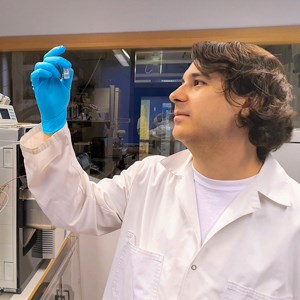Contact
Hugo de Campos Pereira
Department of Soil and Environment, SLU
Hugo.Pereira@slu.se, 0700439976

Highly fluorinated substances, or PFAS substances, are a group of chemicals that in recent years have come to be regarded as environmental contaminants of global concern. In his doctoral thesis, Hugo de Campos Pereira has investigated how PFASs are bound to soil and components therein, including soil organic matter and iron hydroxides. By increasing our knowledge on this, it will be possible to more accurately assess the fate of these compounds in the terrestrial environment.
Large emissions to the environment have occurred at fire-fighting training sites using PFAS-containing fire-fighting foam.
– PFAS substances are found almost everywhere in the environment, including in our drinking water, albeit usually in small amounts. These substances are persistent to degradation and could have adverse health effects in humans and other organisms. Therefore, some of these substances are now being phased out. However, the legacy of global and long-standing emissions will remain to be dealt with for a long time to come, says Hugo de Campos Pereira.
In his doctoral thesis, Hugo has investigated how strongly or weakly PFAS substances are bound in soil, and which chemical binding mechanisms come into play. By increasing our understanding of this, we may achieve more accurate and well-grounded risk assessments of PFAS-contaminated sites.
– I did batch partitioning experiments with soil samples and with components that often are found in the soil such as organic matter and iron minerals. Since PFAS substances are often negatively charged, I investigated factors that may affect the charge of the soil particles, for example the pH value of the soil solution, in connection with the batch experiments. To gain a better understanding of the substances' binding to iron minerals and to organic matter, I used different spectroscopic methods, says Hugo.
In his thesis, Hugo describes the properties of PFAS substances. For example, that the driving force for the overall binding of a certain PFAS substance to mineral soils and organic soil horizons was identified as hydrophobic interaction and how that binding is affected by the acidity of the soil solution.
– For PFASs with more fluorine atoms in their molecule, it was found that the binding strength was affected to a larger extent by the charge present both on the soil particles and on the pure organic material and iron minerals, as compared to that of PFASs with less fluorine atoms. This indicates that the fluorine atoms of the molecule´s “tail” contribute to the overall charge-dependency of the binding, together with the so-called head group of the molecule, says Hugo.
– To develop more accurate models and predict how PFAS substances are bound or leached in the soil environment, we need to do more experiments in the lab and investigate the binding behavior under different conditions, concludes Hugo.
Hugo de Campos Pereira
Department of Soil and Environment, SLU
Hugo.Pereira@slu.se, 0700439976
Read the thesis ”Binding of per- and polyfluoroalkyl substances (PFASs) in soil - Effects of solution chemistry, soil properties, and PFAS structure” here
Hugo de Campos Pereira will defend his doctoral thesis on the 14th of December. Read more about the dissertation here